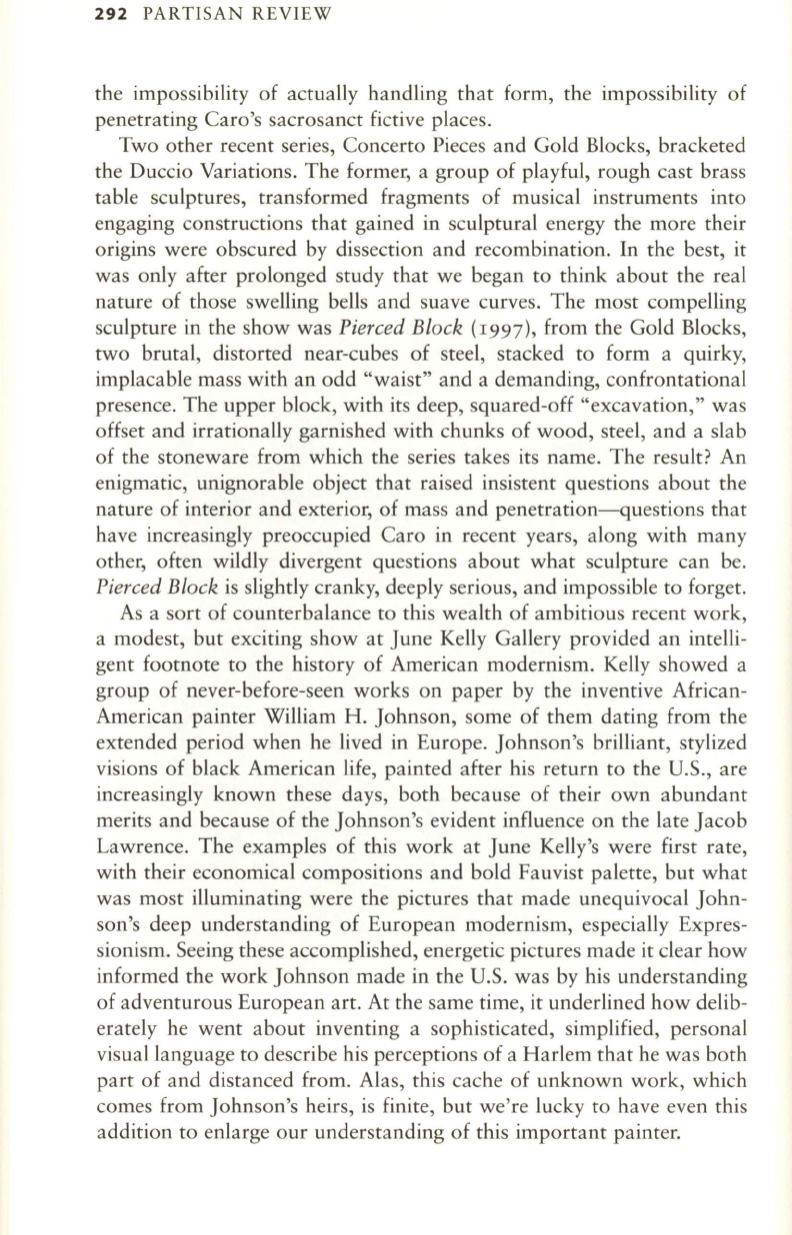
292
PARTISAN REVIEW
the impossibility of actually handling that form, the impossibility of
penetrating Caro's sacrosanct fictive places.
Two other recent series, Concerto Pieces and Gold Blocks, bracketed
the Duccio Variations. The former, a group of playful, rough cast brass
table sculptures, transformed fragments of musical instruments into
engaging constructions that gained in sculptural energy the more their
origins were obscured by dissection and recombination.
In
the best, it
was only after prolonged study that we began to think about the real
nature of those swelling bells and suave curves. The most compelling
sculpture in the show was
Pierced Block
(1997), from the Gold Blocks,
two brutal, distorted near-cubes of steel, stacked to form a quirky,
implacable mass with an odd "waist" and a demanding, confrontational
presence. The upper block, with its deep, squared-off "excavation," was
offset and irrationally garnished with chunks of wood, steel, and a slab
of the stoneware from which the series takes its name. The result? An
enigmatic, unignorable object that raised insistent questions about the
nature of interior and exterior, of mass and penetration-questions that
have increasingly preoccupied Caro in recent years, along with many
other, often wildly divergent questions about what sculpture can be.
Pierced Block
is slightly cranky, deeply serious, and impossible to forget.
As a sort of counterbalance to this wealth of ambitious recent work,
a modest, but exciting show at June Kelly Gallery provided an intelli–
gent footnote to the history of American modernism. Kelly showed a
group of never-beFore-seen works on paper by the inventive African–
American painter William H. Johnson, some of them dating from the
extended period when he lived in Europe. Johnson'S brilliant, stylized
visions of black American life, painted after his return
to
the U.S., are
increasingly known these days, both because of their own abundant
merits and because of the johnson's evident influence on the late Jacob
Lawrence. The examples of this work at June Kelly's were first rate,
with their economical compositions and bold Fauvist palette, but what
was most illuminating were the pictures that made unequivocal John–
son's deep understanding of European modernism, especially Expres–
sionism. Seeing these accomplished, energetic pictures made it clear how
informed the work Johnson made in the U.S. was by his understanding
of adventurous European art. At the same time, it underlined how delib–
erately he went about inventing a sophisticated, simplified, personal
visual language to describe his perceptions of a Harlem that he was both
part of and distanced from. Alas, this cache of unknown work, which
comes from johnson's heirs, is finite, but we're lucky to have even this
addition to enlarge our understanding of this important painter.


